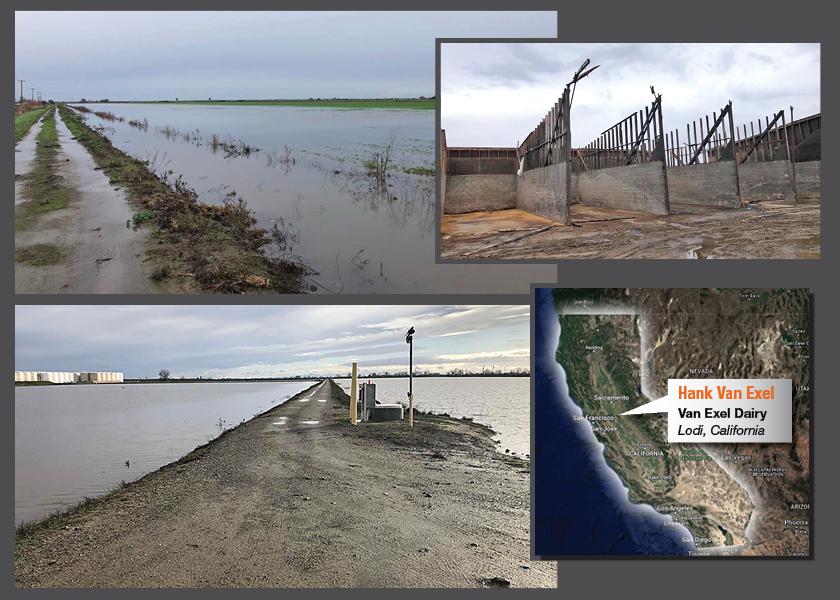Major Flooding: Bomb Cyclone Storm Causing Havoc to California Dairy Farmers

While normally any moisture to the Golden State would be welcomed with open arms by farmers, the massive “Bomb Cyclone” storm hitting California is far from normal. A “Bomb Cyclone,” by definition, is a low-pressure system that experiences a fall in pressure of 24 millibars in 24 hours.
High winds, heavy rain and snow, and power outages have impacted California this week. Dairy farmer Hank Van Exel shares that he has received more than 10 inches in the past week. And, it is still raining at his farm in Lodi, located 40 miles south of Sacramento.
“It has been pouring for the last couple of hours,” he stated yesterday afternoon. “I’m sure we’ll have another inch and a half today.”
Van Exel says massive flooding is occurring around his farm, as well as in areas north.
“I have about 500 acres under water,” he shares. “Most of which we have drained out, but it is all filling up again. It remains to be seen how much feed I will lose but it doesn’t look good.”
In addition to the rain, 49- to 60-mph winds have hit Lodi, causing Van Excel to re-bed freestalls over and over.
“We use rice hulls for the calves and the area to the north where we get that from is flooded,” he says.
Van Exel counts himself fortunate, as so far, his farm has not lost power. Neighboring farms have not fared so well, many of which have been out of power for 24 hours.
“A lot of dairyman have flooded corals and have had to move [cows] out,” he says.
Gov. Gavin Newsom signed a statewide emergency declaration earlier this week to help agencies send aid and resources where needed.
Dams Needed
Geoff Vanden Heuvel, the director of regulatory and economic affairs with the California Milk Producer Council, shared on a 2022 National Milk Producers Federation (NMPF) podcast that the California water issue is complex and long-standing. The state was developed without any regulations on groundwater. He also states that between 85% to 90% of California’s milk supply hails from the Central Valley.
“It’s a vast groundwater basin, millions and millions of acre feet of water reside under the ground, and it was never regulated,” he shares. “Dairyman found large tracks of ground that were available and as long as there was water underneath you, you could put wells in and construct the dairy and began to milk cows and grow feed around the dairy and all was well. California always depended on the Central Valley, a combination of groundwater and surface water.”
Vanden Heuvel says that surface water mainly comes from the rain and snow that occurs in the Sierra Nevada mountains, which is directly to the east of the Central Valley.
“For many years, it was a combination of surface water and groundwater that sustained agriculture in California and created really what is an agriculture marvel in the world. I mean, we grow about 250 different agricultural crops and became home to the nation’s largest dairy industry. Water, it was there, there was a lot of it and there wasn’t a huge barrier to accessing it. So, it wasn’t something we spent a lot of time thinking about,” he says.
Van Exel says that the main cause is that the state of California has not built any dams.
“Especially on the Cosumnes River,” he says. “It runs wild. This dam was voted on years ago, but never built.”
Van Exel says he bets 75% of the extra precipitation that comes out of the “Bomb Cyclone” will go to the ocean.
“The worst is the wind,” he says. “The power companies are having a terrible time trying to restore power and so many of the areas can’t even try to get their pumps going. So, I guess this extra rain is not necessarily a good thing.”
California dairy producer Steve Maddox, located 160 miles southeast of Van Exel, says he has received 3 inches of rain in the past two weeks.
“That’s nearly the same amount we received all season long a few years ago,” Maddox says.
Maddox owns and operates Maddox Dairy, home to 4,000 cows and equal number of replacement heifers, and farms 1,600 acres of almonds and 3,000 acres of wine grapes, as well as cropland to supply feed for their cattle. In 2021, Maddox made the hard decision to fallow a third of his 1,800 acres of corn silage cropland due to water restrictions. He says undoubtedly more dams are needed on the reservoirs.
“Our state needs to be able to store more water. From here on out, just give me snow,” he says.







